Multi-Source DEM Vertical Accuracy Evaluation of Taklimakan Desert Hinterland Based on ICESat-2 ATL08 and UAV Data
Abstract
1. Introduction
2. Materials and Methods
2.1. Study Area
2.2. Data
2.2.1. ICESat-2 ATL08 Data
2.2.2. UAV Data
2.2.3. DEM Data
2.3. Research Method
2.3.1. ICESat-2 ATL08 Data Preprocessing
2.3.2. DEM Data Processing
2.3.3. DEM Vertical Accuracy Evaluation
3. Results
3.1. Evaluation of DEM Elevation Errors in the TD Hinterland
3.2. The Influence of Slope on DEM Vertical Accuracy in the TD Hinterland
3.3. The Influence of Slope Aspect on the Accuracy of DEMs in the TD Hinterland
3.4. The Influence of Terrain Relief on the Vertical Accuracy of DEMs in the TD Hinterland
4. Discussion
4.1. Factors Influencing DEM Vertical Accuracy in the TD Hinterland
4.2. Limitations and Future Prospects
5. Conclusions
Author Contributions
Funding
Data Availability Statement
Acknowledgments
Conflicts of Interest
References
- Ishiyama, T.; Tsuchiya, K.; Sugihara, S. Ground surface features of the Taklimakan Desert. Adv. Space Res. 1996, 17, 41–48. [Google Scholar] [CrossRef]
- Saadat, H.; Bonnell, R.; Sharifi, F.; Mehuys, G.; Namdar, M.; Ale-Ebrahim, S. Landform classification from a digital elevation model and satellite imagery. Geomorphology 2008, 100, 453–464. [Google Scholar] [CrossRef]
- Wang, X.; Dong, Z.; Zhang, J.; Chen, G. Geomorphology of sand dunes in the Northeast Taklimakan Desert. Geomorphology 2002, 42, 183–195. [Google Scholar] [CrossRef]
- Dong, Z.; Wang, X.; Chen, G. Monitoring sand dune advance in the Taklimakan Desert. Geomorphology 2000, 35, 219–231. [Google Scholar] [CrossRef]
- Dong, Z.; Wei, Z.; Qian, G.; Zhang, Z.; Luo, W.; Hu, G. “Raked” linear dunes in the Kumtagh Desert, China. Geomorphology 2010, 123, 122–128. [Google Scholar] [CrossRef]
- Li, S.; Xiong, L.; Tang, G.; Strobl, J. Deep learning-based approach for landform classification from integrated data sources of digital elevation model and imagery. Geomorphology 2020, 354, 107045. [Google Scholar] [CrossRef]
- Telbisz, T.; Keszler, O. DEM-based morphometry of large-scale sand dune patterns in the Grand Erg Oriental (Northern Sahara Desert, Africa). Arab. J. Geosci. 2018, 11, 382. [Google Scholar] [CrossRef]
- Wang, M.; Liu, Y.; Li, H.; Wang, M.; Huo, W.; Liu, Z. A Novel Algorithm for Estimating the Sand Dune Density of the Taklimakan Desert Based on Remote Sensing Data. Remote Sens. 2025, 17, 297. [Google Scholar] [CrossRef]
- Niu, Z.; Wang, N.; Meng, N.; Liu, J.; Liang, X.; Cheng, H.; Wen, P.; Yu, X.; Zhang, W.; Liang, X. Contribution of Lake-Dune Patterning to the Dune Height of Mega-Dunes in the Badain Jaran Sand Sea, Northern China. Remote Sens. 2021, 13, 4915. [Google Scholar] [CrossRef]
- Megahed, H.A.; Hassoup, A.; Farrag, A.E.A.; Wahba, D. Modeling the environmental hazards of el-kharga oasis sand dunes, western desert of Egypt, using remote sensing and GIS techniques. Int. J. Adv. Remote Sens. GIS 2021, 10, 3501–3520. [Google Scholar] [CrossRef]
- Daynac, J.; Bessin, P.; Pochat, S.; Mourgues, R.; Shumack, S. A new workflow for mapping dune features (outline, crestline and defects) combining deep learning and skeletonization from DEM-derived data. Geomorphology 2024, 463, 109369. [Google Scholar] [CrossRef]
- Trevisani, S.; Guth, P.L. Terrain Analysis According to Multiscale Surface Roughness in the Taklimakan Desert. Land 2024, 13, 1843. [Google Scholar] [CrossRef]
- Shumack, S.; Hesse, P.; Farebrother, W. Deep learning for dune pattern mapping with the AW3D30 global surface model. Earth Surf. Process. Landf. 2020, 45, 2417–2431. [Google Scholar] [CrossRef]
- White, K.; Bullard, J.; Livingstone, I.; Moran, L. A morphometric comparison of the Namib and southwest Kalahari dunefields using ASTER GDEM data. Aeolian Res. 2015, 19, 87–95. [Google Scholar] [CrossRef]
- Desroches, D.; Gasnier, N. Digital Elevation Models of Some Land Surfaces from Interferometric Processing of Swot Images. In Proceedings of the IGARSS 2024—2024 IEEE International Geoscience and Remote Sensing Symposium, Athens, Greece, 7–12 July 2024; pp. 3172–3175. [Google Scholar] [CrossRef]
- Xu, N.; Wang, L.; Xu, H.; Ma, Y.; Li, Y.; Wang, X.H. Deriving Accurate Intertidal Topography for Sandy Beaches Using ICESat-2 Data and Sentinel-2 Imagery. J. Remote Sens. 2024, 4, 305. [Google Scholar] [CrossRef]
- Ding, C.; Feng, G.; Zhang, L.; Liao, M. A Novel Multidimensional Perspective on Dynamic Characteristics of the Peculiar Feather-Shaped Dunes in Kumtag Desert With Time-Series Optical and SAR Observations. IEEE J. Sel. Top. Appl. Earth Observ. Remote Sens. 2024, 17, 11618–11631. [Google Scholar] [CrossRef]
- Li, H.; Zhao, J.; Yan, B.; Yue, L.; Wang, L. Global DEMs vary from one to another: An evaluation of newly released Copernicus, NASA and AW3D30 DEM on selected terrains of China using ICESat-2 altimetry data. Int. J. Digit. Earth. 2022, 15, 1149–1168. [Google Scholar] [CrossRef]
- Rehman, K.; Fareed, N.; Chu, H. NASA ICESat-2: Space-Borne LiDAR for Geological Education and Field Mapping of Aeolian Sand Dune Environments. Remote Sens. 2023, 15, 2882. [Google Scholar] [CrossRef]
- Dandabathula, G.; Roy, S.; Ghatage, O.S.; Kolase, V.B.; Satpute, S.; Ghosh, K.; Kaur, S.; Pondari, S.; Bera, A.K.; Srivastav, S.K. Performance validation of High Mountain Asia 8-meter Digital Elevation Model using ICESat-2 geolocated photons. J. Mt. Sci. 2024, 21, 2562–2578. [Google Scholar] [CrossRef]
- Narin, O.G.; Gullu, M. A comparison of vertical accuracy of global DEMs and DEMs produced by GEDI, ICESat-2. Earth Sci. Inform. 2023, 16, 2693–2707. [Google Scholar] [CrossRef]
- Huang, X.; Xie, H.; Liang, T.; Yi, D. Estimating vertical error of SRTM and map-based DEMs using ICESat altimetry data in the eastern Tibetan Plateau. Int. J. Remote Sens. 2011, 32, 5177–5196. [Google Scholar] [CrossRef]
- Smith, S.L. Drones over the “Black Desert”: The advantages of rotary-wing UAVs for complementing archaeological fieldwork in the hard-to-access landscapes of preservation of north-eastern Jordan. Geosciences 2020, 10, 426. [Google Scholar] [CrossRef]
- Liu, B.; Sun, A.; Zhao, H.; Fan, Y.; Yang, L.; Li, Y.; Li, S.; Wang, K. Physicochemical properties of surface sediments in the Taklimakan desert, northwestern China, and their relationship with oasis-desert evolution. Catena 2022, 208, 105751. [Google Scholar] [CrossRef]
- Han, Z.W.; Dong, Z.B.; Wang, T.; Chen, G.T.; Yan, C.Z.; Yao, Z.Y. Observations of several characteristics of aeolian sand movement in the Taklimakan Desert. Sci. China Ser. D-Earth Sci. 2004, 47, 86–96. [Google Scholar] [CrossRef]
- Ningbo, W.; Feng, G.; Shengyu, L. Fractality and Stability of Sand Dunes in Lowland among Composite Longitudinal Ridges in the Central Taklimakan Desert. Arid. Zone Res. 2014, 31, 163–168. (In Chinese) [Google Scholar] [CrossRef]
- Markus, T.; Neumann, T.; Martino, A.; Abdalati, W.; Brunt, K.; Csatho, B.; Farrell, S.; Fricker, H.; Gardner, A.; Harding, D.; et al. The Ice, Cloud, and land Elevation Satellite-2 ( ICESat-2): Science requirements, concept, and implementation. Remote Sens. Environ. 2017, 190, 260–273. [Google Scholar] [CrossRef]
- Neuenschwander, A.; Pitts, K. The ATL08 land and vegetation product for the ICESat-2 Mission. Remote Sens. Environ. 2019, 221, 247–259. [Google Scholar] [CrossRef]
- Franks, S.; Rengarajan, R. Evaluation of Copernicus DEM and comparison to the DEM used for Landsat Collection-2 processing. Remote Sens. 2023, 15, 2509. [Google Scholar] [CrossRef]
- Guth, P.L.; Geoffroy, T.M. LiDAR point cloud and ICESat-2 evaluation of 1 second global digital elevation models: Copernicus wins. Trans. Gis. 2021, 25, 2245–2261. [Google Scholar] [CrossRef]
- Takaku, J.; Tadono, T.; Doutsu, M.; Ohgushi, F.; Kai, H. Updates of ‘AW3D30’ALOS global digital surface model with other open access datasets. Int. Arch. Photogramm. Remote Sens. Spat. Inf. Sci. 2020, 43, 183–189. [Google Scholar] [CrossRef]
- Tachikawa, T.; Hato, M.; Kaku, M.; Iwasaki, A. Characteristics of ASTER GDEM version 2. In Proceedings of the 2011 IEEE International Geoscience and Remote Sensing Symposium, Vancouver, BC, Canada, 24–29 July 2011; pp. 3657–3660. [Google Scholar] [CrossRef]
- Farr, T.G.; Rosen, P.A.; Caro, E.; Crippen, R.; Duren, R.; Hensley, S.; Kobrick, M.; Paller, M.; Rodriguez, E.; Roth, L.; et al. The shuttle radar topography mission. Rev. Geophys. 2007, 45, RG2004. [Google Scholar] [CrossRef]
- Crippen, R.; Buckley, S.; Agram, P.; Belz, E.; Gurrola, E.; Hensley, S.; Kobrick, M.; Lavalle, M.; Martin, J.; Neumann, M.; et al. NASADEM global elevation model: Methods and progress. Int. Arch. Photogramm. Remote Sens. Spat. Inf. Sci. 2016, 41, 125–128. [Google Scholar] [CrossRef]
- Wei, Y.; Gan, S.; Yuan, X.; Hu, L.; Gao, S. Analysis of Topographic Feature Parameters of Dinosaur Valley Ring Tectonic Geomorphology Based on the Advanced Land Observing Satellite Digital Elevation Model (ALOS DEM). Appl. Sci. 2023, 13, 13137. [Google Scholar] [CrossRef]
- Zheng, Y.; Zhang, Y.; Wang, T.; Zhao, X.; Zhang, K.; Wang, L. Elevation control points extraction and accuracy validation based on ICESat-2 data. J. Geo-Inf. Sci. 2022, 24, 1234–1244. [Google Scholar]
- Weifeng, X.; Jun, L.; Dailiang, P.; Jinge, J.; Hongxuan, X.; Hongyue, Y.; Jun, Y. Multi-source DEM accuracy evaluation based on ICESat-2 in Qinghai-Tibet Plateau, China. Int. J. Digit. Earth. 2024, 17, 2297843. [Google Scholar] [CrossRef]
- Li, W.; Wang, C.; Zhu, W. Error spatial distribution characteristics of TanDEM-X 90m DEM over China. J. Geo-Inf. Sci. 2020, 22, 2277–2288. [Google Scholar]
- Hoehle, J.; Hoehle, M. Accuracy assessment of digital elevation models by means of robust statistical methods. ISPRS-J. Photogramm. Remote Sens. 2009, 64, 398–406. [Google Scholar] [CrossRef]
- Tian, X.; Shan, J. Comprehensive evaluation of the ICESat-2 ATL08 terrain product. IEEE Trans. Geosci. Remote Sens. 2021, 59, 8195–8209. [Google Scholar] [CrossRef]
- Wang, X.; Liang, X.; Gong, W.; H A Kli, P.; Wang, Y. Accuracy fluctuations of ICESat-2 height measurements in time series. Int. J. Appl. Earth Obs. Geoinf. 2024, 135, 104234. [Google Scholar] [CrossRef]
- Neuenschwander, A.; Guenther, E.; White, J.C.; Duncanson, L.; Montesano, P. Validation of ICESat-2 terrain and canopy heights in boreal forests. Remote Sens. Environ. 2020, 251, 112110. [Google Scholar] [CrossRef]
- McKee, E.D. A Study of Global Sand Seas; US Government Printing Office: Washington, DC, USA, 1979; Volume 1052. [Google Scholar]
- Szabó, G.; Singh, S.K.; Szabó, S. Slope angle and aspect as influencing factors on the accuracy of the SRTM and the ASTER GDEM databases. Phys. Chem. Earth Parts A/B/C 2015, 83, 137–145. [Google Scholar] [CrossRef]
- Vaze, J.; Teng, J.; Spencer, G. Impact of DEM accuracy and resolution on topographic indices. Environ. Model. Softw. 2010, 25, 1086–1098. [Google Scholar] [CrossRef]
- Liu, Z.; Zhu, J.; Fu, H.; Zhou, C.; Zuo, T. Evaluation of the Vertical Accuracy of Open Global DEMs over Steep Terrain Regions Using ICESat Data: A Case Study over Hunan Province, China. Sensors 2020, 20, 4865. [Google Scholar] [CrossRef]
- Sharma, A.; Bagri, D.S. Comparison and Validation of Elevation Data at Selected Ground Control Points and Terrain Derivatives Derived from Different Digital Elevation Models. Remote Sens. Earth Syst. Sci. 2023, 6, 38–59. [Google Scholar] [CrossRef]
- Khattab, M.I.; Abotalib, A.Z.; Othman, A.; Selim, M.K. Evaluation of multiple digital elevation models for hypsometric analysis in the watersheds affected by the opening of the Red Sea. Egypt. J. Remote Sens. Space Sci. 2023, 26, 1020–1035. [Google Scholar] [CrossRef]
- Adiri, Z.; Lhissou, R.; Maacha, L.; Jilali, A.; Talbi, E.H.; Jellouli, A.; Chakouri, M. Comparison of ASTER GDEM3, SRTM3, NASADEM, TanDEM-X90, AW3D30, and ALOS PALSAR data with TanDEM-X12: A case study of Tagragra of Akka inlier, Moroccan Anti-Atlas. Arab. J. Geosci. 2022, 15, 1654. [Google Scholar] [CrossRef]
- Wu, S.; Li, J.; Huang, G.H. A study on DEM-derived primary topographic attributes for hydrologic applications: Sensitivity to elevation data resolution. Appl. Geogr. 2008, 28, 210–223. [Google Scholar] [CrossRef]
- Zhou, A.; Chen, Y.; Wilson, J.P.; Chen, G.; Min, W.; Xu, R. A multi-terrain feature-based deep convolutional neural network for constructing super-resolution DEMs. Int. J. Appl. Earth Obs. Geoinf. 2023, 120, 103338. [Google Scholar] [CrossRef]
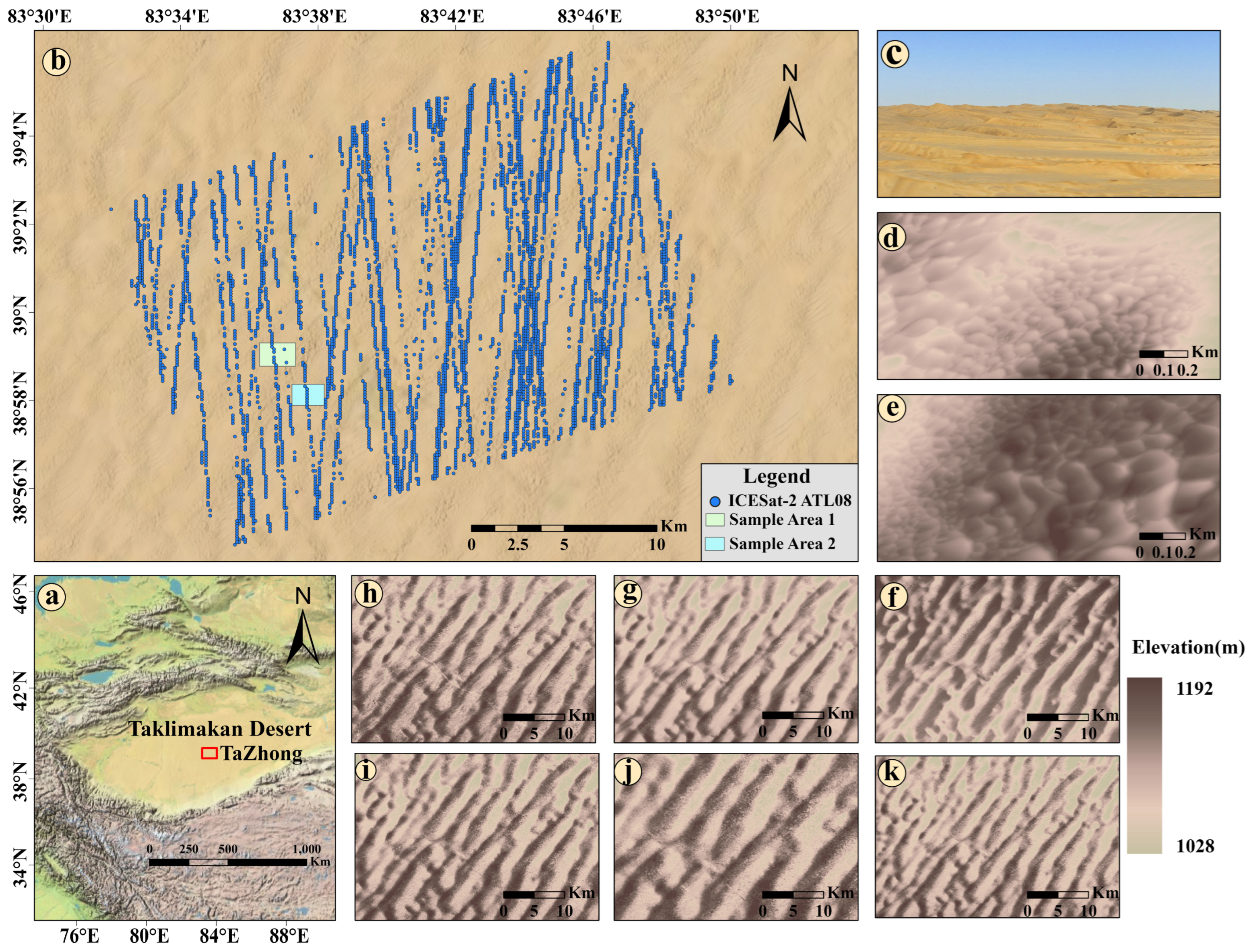
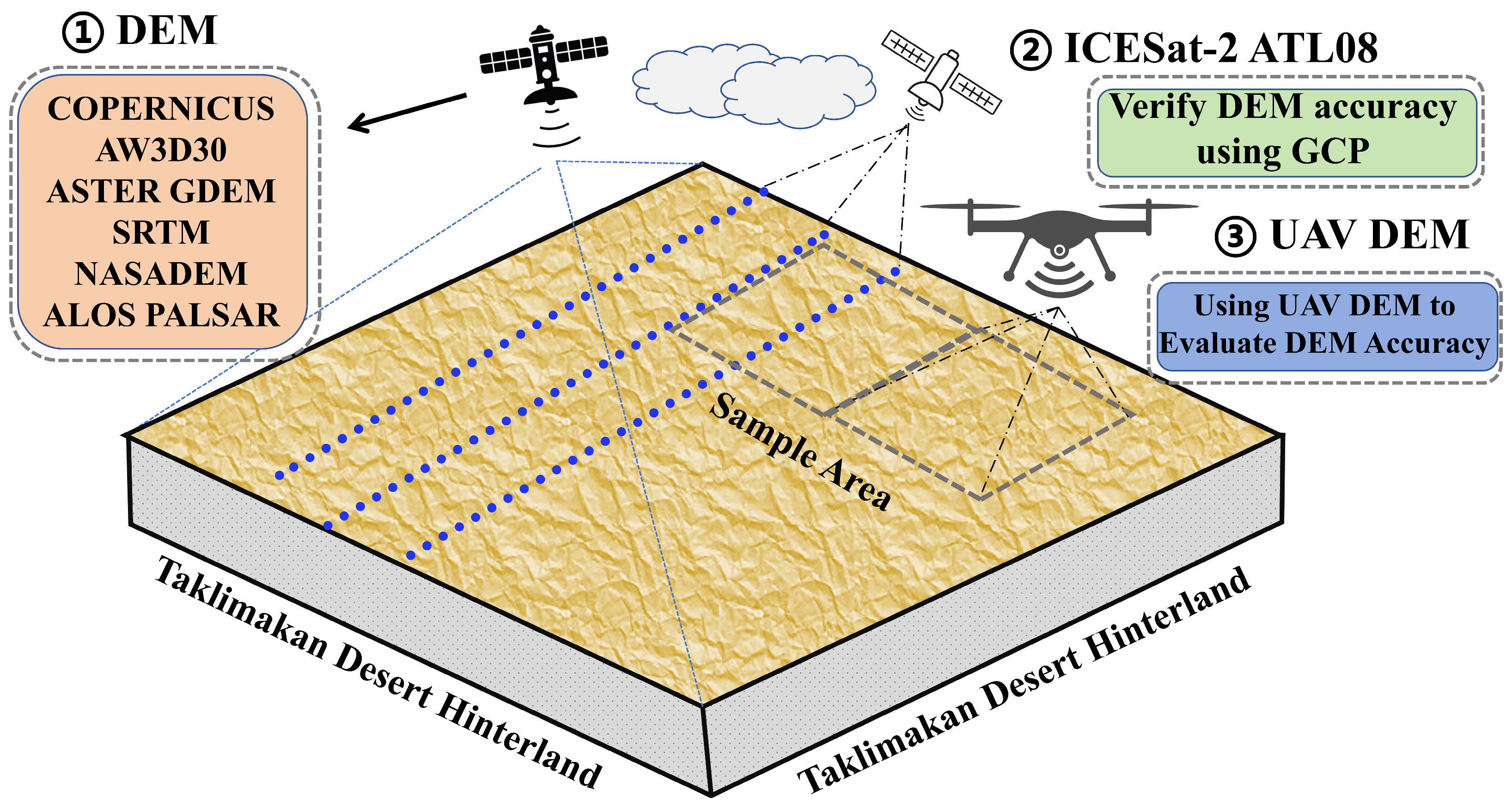

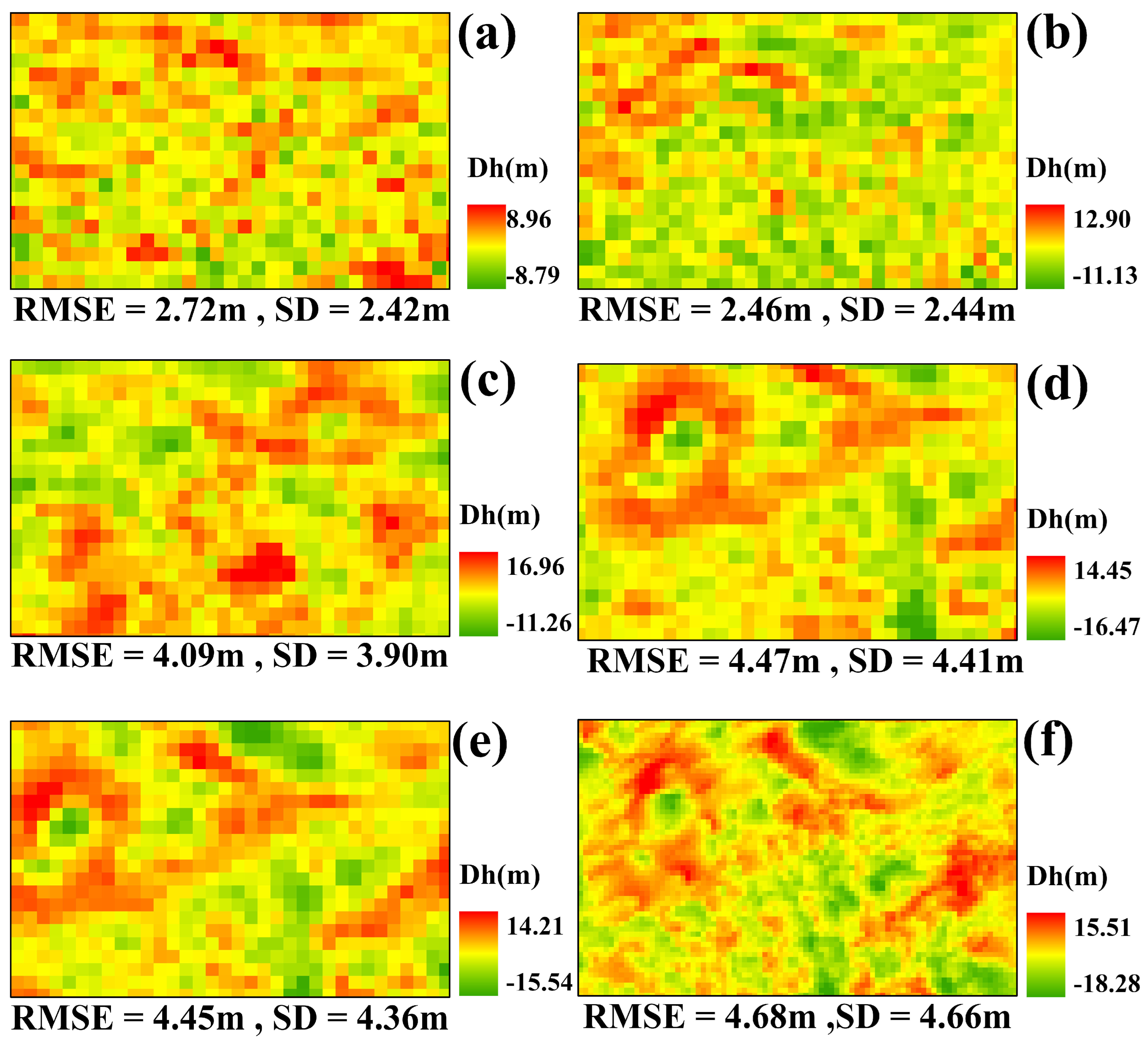
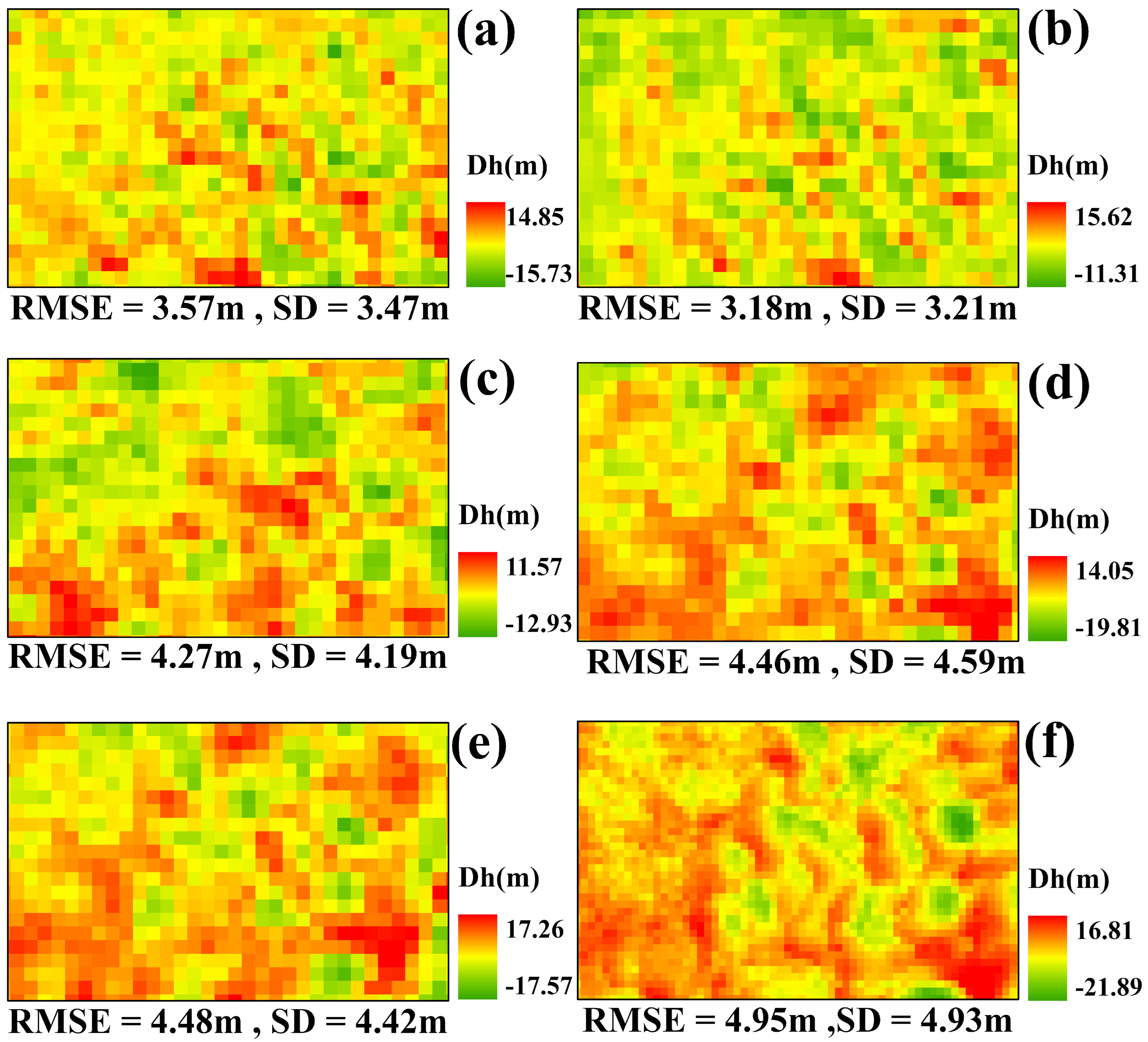
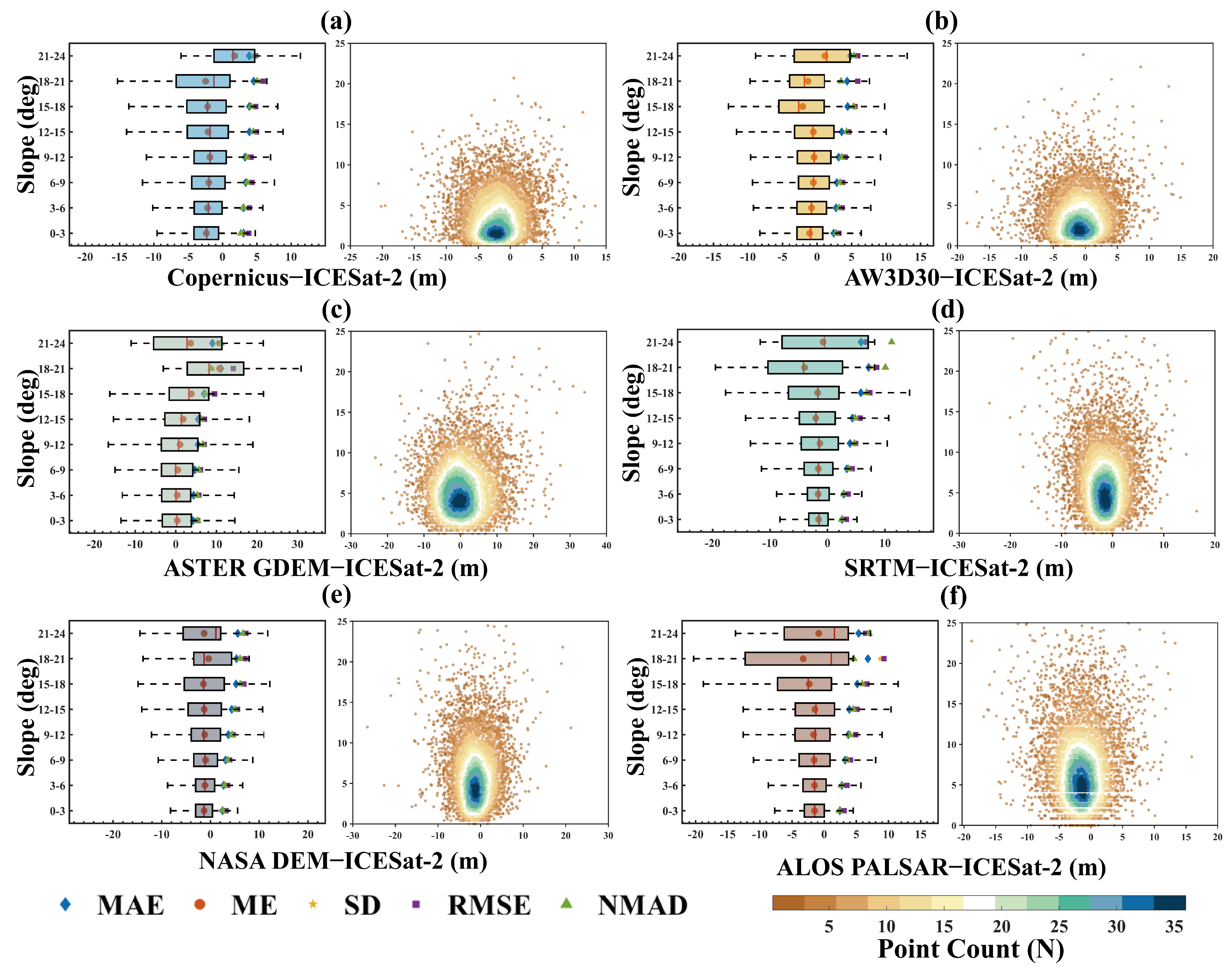
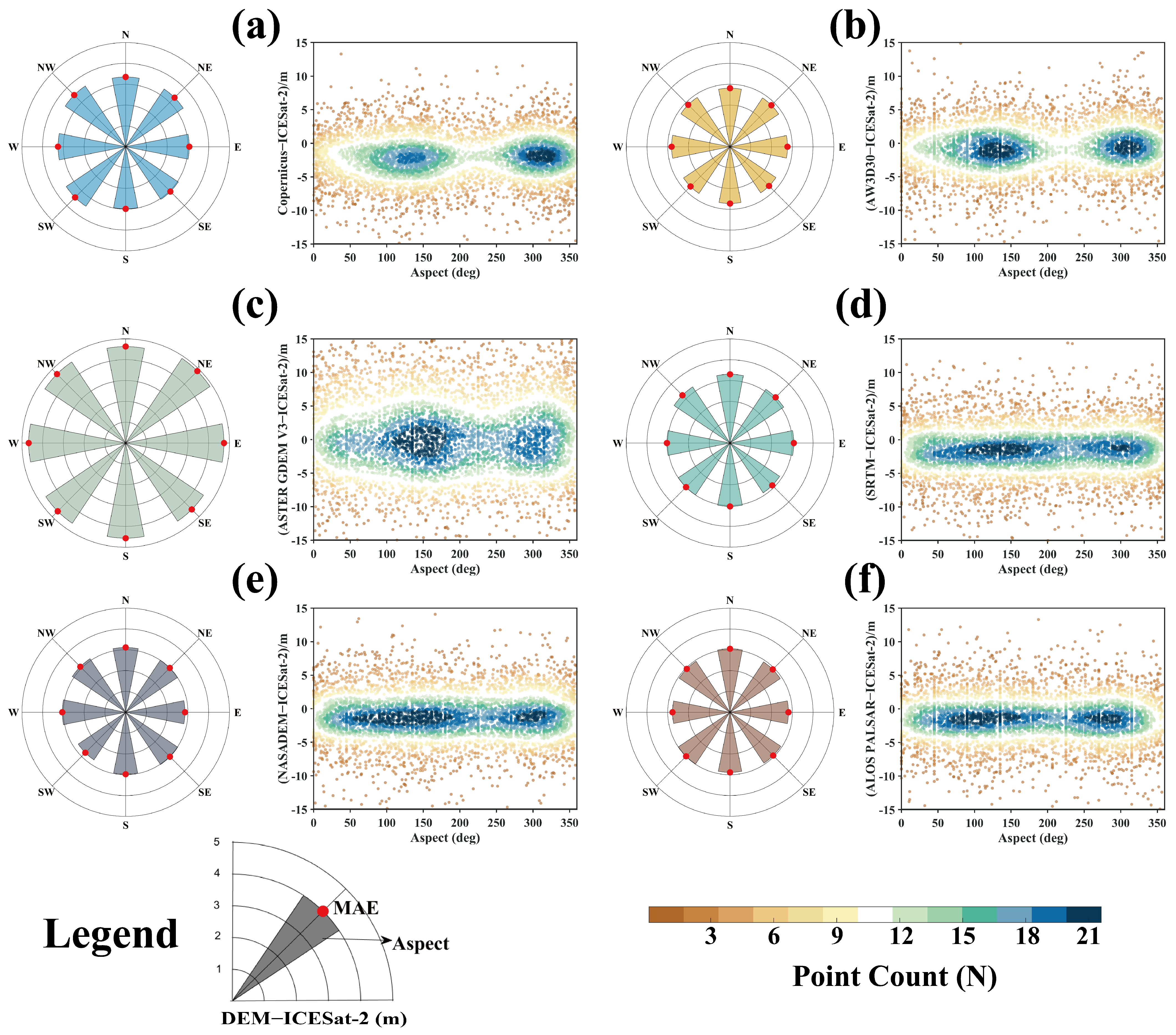

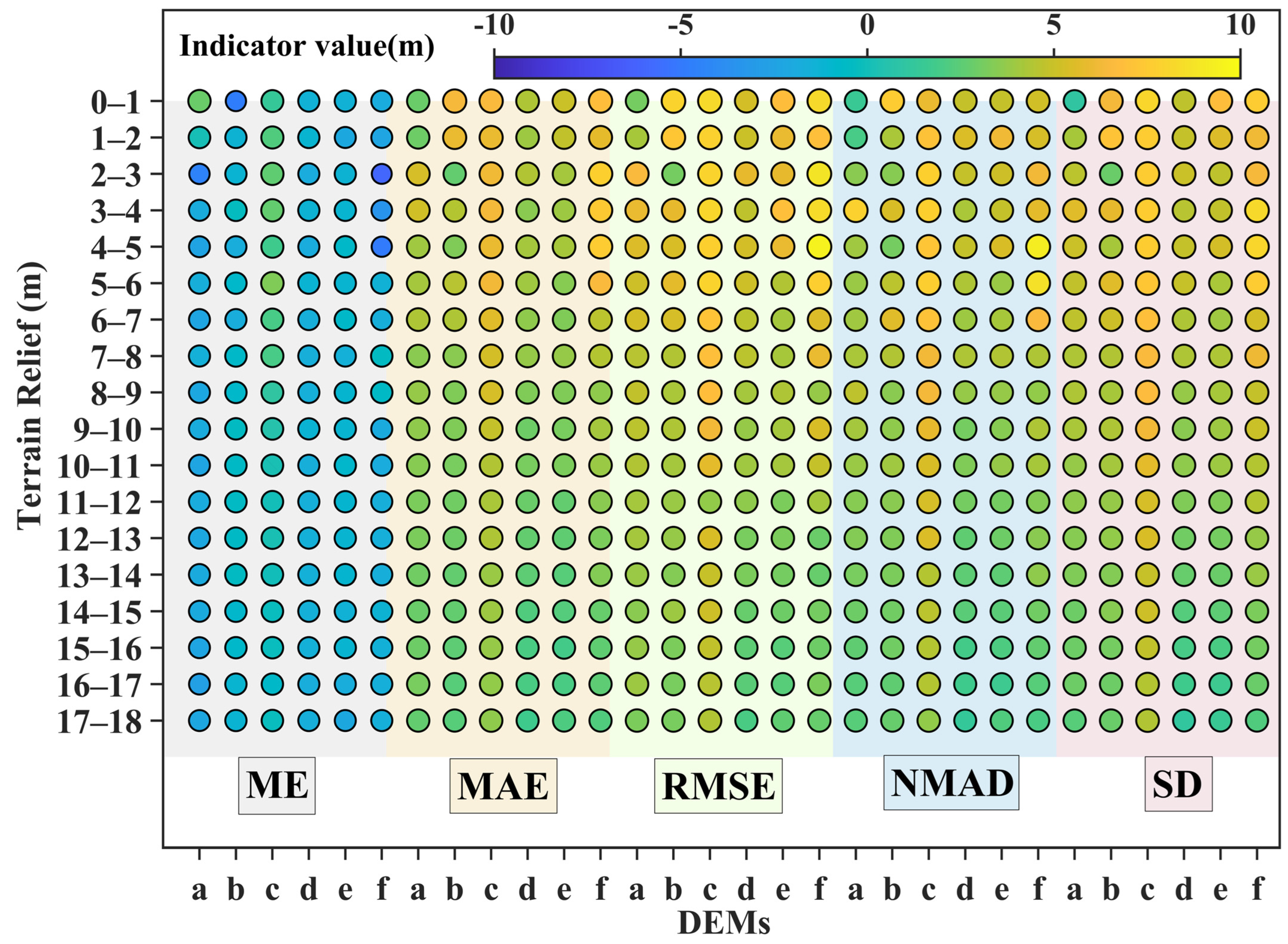
| Datasets | Resolution (m) | Acquired | Producer | Datum Plain/Vertical | Method Source | Vertical Accuracy (m) |
|---|---|---|---|---|---|---|
| ICESat-2 ATL08 | 0.7 | 28 October 2018–17 July 2024 | NASA | WGS84/WGS84 | Photon-counting | 0.1 |
| UAV-DEM | 0.1 | 9 April 2024 | / | WGS84/WGS84 | Orthophotography | 0.3 |
| Copernicus | 30 | 2010–2015 | ESA | WGS84/EGM2008 | X-band radar | 4 |
| AW3D30 | 30 | 2006–2011 | JAXA | WGS84/EGM96 | Stereo pan imagery | ~4.4 (RMSE) |
| ASTER GDEM V3 | 30 | 2000–2013 | NASA/METI | WGS84/EGM96 | Stereo NIR imagery | ~8.5 (RMSE) |
| SRTM v3 | 30 | 2000 | NASA | WGS84/EGM96 | C-band SAR | 9 |
| NASADEM | 30 | 1999–2000 | NASA | WGS84/EGM96 | C-band SAR | Not reported |
| ALOS PALSAR | 12.5 | 2006–2011 | ASF | WGS84/WGS84 | L-band radar | ∼5 |
| Evaluation Indicators | Explanation | Formula | |
|---|---|---|---|
| Elevation Difference (d) | Represents the difference between DEM elevation and GCP elevation in desert areas. | (3) | |
| Standard Deviation (SD) | Indicates the degree of dispersion of elevation difference d near the average error ME. | (4) | |
| Normalized Median Absolute Deviation (NMAD) | Represents the absolute difference between the elevation difference d and the median and is an estimate of the standard deviation with a heavy-tailed non-normal distribution [39]. | (5) | |
| Root Mean Square Error (RMSE) | Measures the overall accuracy of DEM data. | (6) | |
| Mean Error (ME) | Represents the average difference between DEM and GCP elevations. | d represents elevation error; n represents the number of GCPs. | (7) |
| Mean Absolute Error (MAE) | Represents the average absolute difference between DEM and GCP elevations. | (8) | |
Disclaimer/Publisher’s Note: The statements, opinions and data contained in all publications are solely those of the individual author(s) and contributor(s) and not of MDPI and/or the editor(s). MDPI and/or the editor(s) disclaim responsibility for any injury to people or property resulting from any ideas, methods, instructions or products referred to in the content. |
© 2025 by the authors. Licensee MDPI, Basel, Switzerland. This article is an open access article distributed under the terms and conditions of the Creative Commons Attribution (CC BY) license (https://creativecommons.org/licenses/by/4.0/).
Share and Cite
Wang, M.; Li, H.; Liu, Y.; Li, H. Multi-Source DEM Vertical Accuracy Evaluation of Taklimakan Desert Hinterland Based on ICESat-2 ATL08 and UAV Data. Remote Sens. 2025, 17, 1807. https://doi.org/10.3390/rs17111807
Wang M, Li H, Liu Y, Li H. Multi-Source DEM Vertical Accuracy Evaluation of Taklimakan Desert Hinterland Based on ICESat-2 ATL08 and UAV Data. Remote Sensing. 2025; 17(11):1807. https://doi.org/10.3390/rs17111807
Chicago/Turabian StyleWang, Mingyu, Huoqing Li, Yongqiang Liu, and Haojuan Li. 2025. "Multi-Source DEM Vertical Accuracy Evaluation of Taklimakan Desert Hinterland Based on ICESat-2 ATL08 and UAV Data" Remote Sensing 17, no. 11: 1807. https://doi.org/10.3390/rs17111807
APA StyleWang, M., Li, H., Liu, Y., & Li, H. (2025). Multi-Source DEM Vertical Accuracy Evaluation of Taklimakan Desert Hinterland Based on ICESat-2 ATL08 and UAV Data. Remote Sensing, 17(11), 1807. https://doi.org/10.3390/rs17111807







